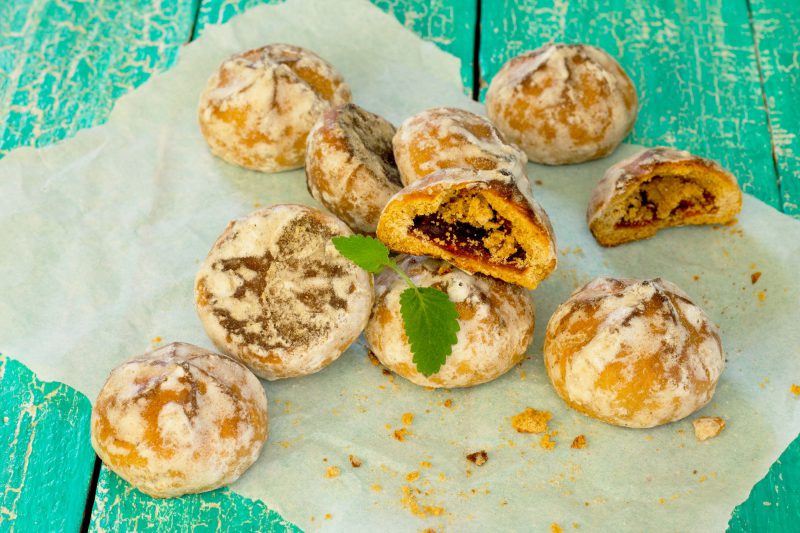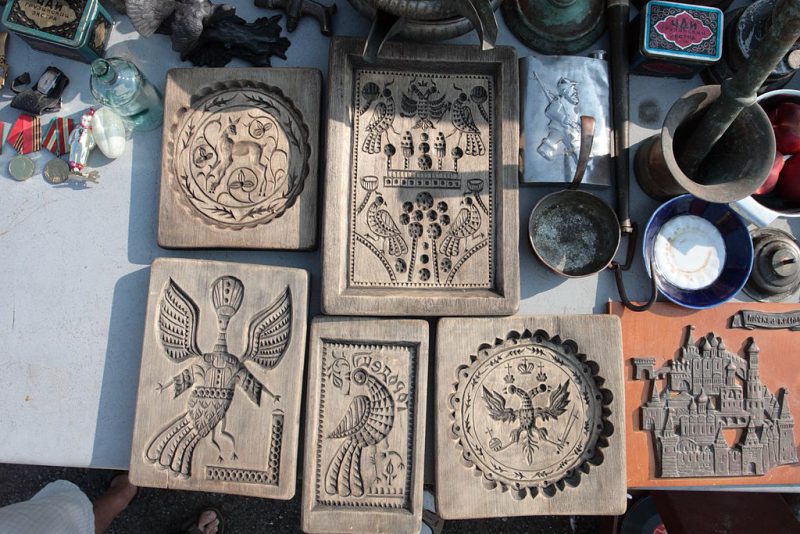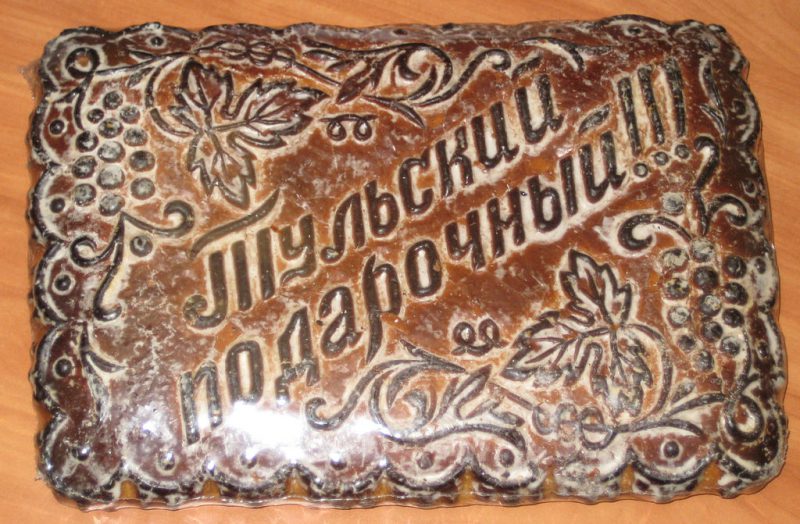Pryanik – Russian version of gingerbread
Pryanik (which can be literally translated as “spice-cake” and more often as “gingerbread”, although it rarely includes ginger) is a confectionery baked using a special dough, which is achieved by combining a large amount of sugar, honey and spices. Pryaniki are usually made in the form of small thick flat cakes coated with pastry glaze. Nuts, candied fruits, raisins, fruit or berry jam can be added to the dough for taste.

Pryaniki’s story
The first written references to spiced honey cakes dates back to the 4th century BC. In Russia, pryaniki appeared in the 9th century AD and were called “honey bread”. At that time, they were made from rye flour, berry juice and honey (which amounted up to half of the whole mixture). Later, people started adding various herbs, roots and spices brought by traders from the Middle East and India.
In ancient Russia, pryaniki had always been considered a festive delicacy because of the high price of its ingredients. From the 15th century onwards, pryaniki had become an integral part of Russian national culture and were present in all spheres of life from daily routines to festivals and fairs.
Pryaniki were served both to the royal table and in peasant homes. They were baked as gifts for birthdays, as a treat for weddings amongst other celebrations, or used as Christmas tree decorations. It was soon became a custom to give pryaniki on Forgiveness Sunday, the last day of Maslenitsa before Lent begins.
Pryaniki given as presents for the rich were baked by special order and weighed up to several poods (1 pood is about 16.3 kg).
From the 17th to the 19th century, pryanik baking became a merchandising activity in Russia. The most popular pryaniki were made in Moscow, Arkhangelsk, Vologda, Vyazmensk, Gorodets, Tula, and Tver.

Varieties of pryaniki
The Russian word pryanik (пря́ник) comes from the adjective пря́ный meaning “spiced up”. A variety of spices can be added to pryaniki to diversify their taste: black pepper, ginger, vanilla, cumin, anise, nutmeg, cloves, lemon, mint, coriander, cardamom, cinnamon – you name it.
There are three types of pryaniki, which differ through their preparation methods: imprinted, cut or molded by hand. The cut ones, as the name suggests, are cut out from the dough using a metal mold. The imprinted pryaniki are made with a wooden printing board.

One of the varieties of imprinted pryaniki is the so-called “razgonnyi pryanik” which can be freely translated as “goodbye pryanik”. At the end of the meal, if some guests were staying a little bit too long, the host used to give to each one a “razgonnyi pryanik” as a signal that it was time to go home.
The type of dough also plays a role; there are uncooked dough pryaniki and precooked dough ones. Precooked dough pryaniki are prepared from a precooked flour with the addition of hot sugar syrup and honey, while uncooked dough pryaniki are prepared with flour containing a lot of sugar, which helps the dough swell faster.
Pryanik recipes
Pryanik dough is fairly easy to prepare. The process consists in combining all of its ingredients and thorough mixing. Pryaniki can be then frozen and stored for several months. The defrosted pryaniki taste as fresh as they were on the day they were cooked. Put in an airtight container, they stay fresh up to 14 days.
Precooked-dough honey pryaniki
The precooked-dough honey pryaniki are soft, and remain tender and tasty for a long time. To make them you will need:
Ingredients for the dough
Flour: 1.5 glasses
Honey: 0.5 cup
Butter: 1 pack (200-250 g)
Egg: 1 pc.
Rum: 1 tbsp.
Sour cream: 30-40 g
Spices: cinnamon, nutmeg, cardamom, cloves (by taste)
Ingredients for the glaze (about 30 portions)
Egg white: 1 pc.
Sugar powder: 200 g
Lemon juice: a few drops
Preparation
1. Melt the butter and mix it with honey, heat everything up on a stove to ca. 75°C.
2. Gradually add half of the flour and all the spices. Quickly mix everything. The mass should become dense. Now it has to cool down.
3. Add the remaining products to the cooled mass and mix well until homogeneous, and almost plastic-like.
4. Roll out the dough, cut out the pryaniki and bake them for 10-15 minutes at 200°C.
5. Make the glaze: Gently whisk the egg white and start adding powdered sugar gradually, sifting it through a sieve. Add the lemon juice. Continue whisking the mixture until the glaze reaches a viscous consistency. Feel free to add more or less powdered sugar if you want the glaze to be more or less thick.
6. Get the pryaniki out of the oven and cover them with the glaze while they are still hot. The glaze is supposed to dry up in about 10-15 minutes.
Tula pryanik
Tula pryaniki is the most famous type of imprinted Russian pryaniki and come originally from the city of Tula. Usually, Tula pryaniki look like a rectangular tile and include a jam filling.

Today we offer you a recipe of home-made Tula pryanik with a jam filling:
Ingredients
Honey: 3 tbsp.
Egg: 2 pc.
Sugar: 1 glass
Flour: +/- 350 g (adjust depending on dough consistency)
Cinnamon: 1/2 tsp.
Butter: 100 g
Soda: 1 tsp.
Apricot jam: 4 tbsp.
Preparation
1. Add sugar, butter, eggs, cinnamon, soda, and honey in a saucepan and put it in a water bath (i.e. put the saucepan in a larger one, which you fill water up to half of it and turn the heat on).
2. Melt everything until the mixture turns liquid. It should be covered with white foam.
3. Take the mixture off fire and begin to add flour little by little and stir constantly. Do it until it becomes hard to stir.
4. Take the dough out of the saucepan and continue kneading by hand. You should get an elastic and smooth dough that does not sticky to the hands nor the table.
5. Cover the baking sheet with baking paper and smear it with vegetable oil.
6. Divide the dough in 2. Roll one out, so that is 0.5–0.6cm thick. Smear the dough with jam leaving the edges clear, otherwise the two doughs will not stick together.
7. Roll out the second part of the dough and cover the first part with it. Make sure that the edges are nicely stuck together to prevent the jam from to running out.
8. Bake the pryanik at 180°C for ca. 30-35 minutes.
9. Take it out of the oven and cover with glaze (like for the previous recipe). When the pryanik is cooled down, cut it into pieces and serve.
Do you have your own recipes for pryaniki? Let us know in the comment!






It’s look like delicious. This is a good idea. I will definitely cook this on the weekends.
Is there an English measurement version for pryanik (this recipe)?
Hello JoAnn,
1 oz is about 28 g. It is easy to calculate. Everything else is approximative anyway.